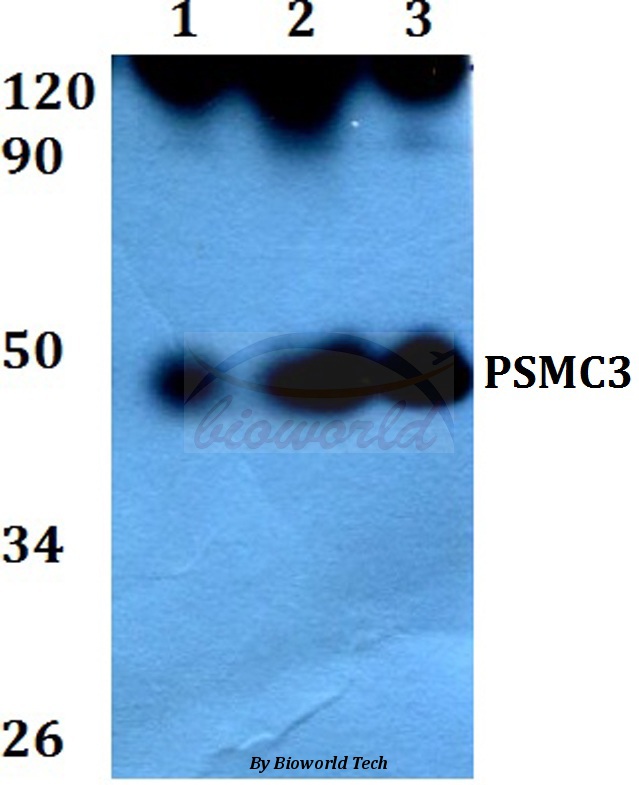PSMC3 antibody [N1C2]
GTX109605
ApplicationsImmunoFluorescence, Western Blot, ImmunoCytoChemistry, ImmunoHistoChemistry, ImmunoHistoChemistry Paraffin
Product group Antibodies
ReactivityHuman, Zebra Fish
TargetPSMC3
Overview
- SupplierGeneTex
- Product NamePSMC3 antibody [N1C2]
- Delivery Days Customer9
- Application Supplier NoteWB: 1:5000-1:20000. ICC/IF: 1:100-1:1000. IHC-P: 1:100-1:1000. *Optimal dilutions/concentrations should be determined by the researcher.Not tested in other applications.
- ApplicationsImmunoFluorescence, Western Blot, ImmunoCytoChemistry, ImmunoHistoChemistry, ImmunoHistoChemistry Paraffin
- CertificationResearch Use Only
- ClonalityPolyclonal
- Concentration1 mg/ml
- ConjugateUnconjugated
- Gene ID5702
- Target namePSMC3
- Target descriptionproteasome 26S subunit, ATPase 3
- Target synonymsDCIDP, RPT5, TBP1, 26S proteasome regulatory subunit 6A, 26S protease regulatory subunit 6A, 26S proteasome AAA-ATPase subunit RPT5, Tat-binding protein 1, human immunodeficiency virus tat transactivator binding protein-1, proteasome (prosome, macropain) 26S subunit, ATPase, 3, proteasome subunit P50, testicular secretory protein Li 42
- HostRabbit
- IsotypeIgG
- Protein IDP17980
- Protein Name26S proteasome regulatory subunit 6A
- Scientific DescriptionThe 26S proteasome is a multicatalytic proteinase complex with a highly ordered structure composed of 2 complexes, a 20S core and a 19S regulator. The 20S core is composed of 4 rings of 28 non-identical subunits; 2 rings are composed of 7 alpha subunits and 2 rings are composed of 7 beta subunits. The 19S regulator is composed of a base, which contains 6 ATPase subunits and 2 non-ATPase subunits, and a lid, which contains up to 10 non-ATPase subunits. Proteasomes are distributed throughout eukaryotic cells at a high concentration and cleave peptides in an ATP/ubiquitin-dependent process in a non-lysosomal pathway. An essential function of a modified proteasome, the immunoproteasome, is the processing of class I MHC peptides. This gene encodes one of the ATPase subunits, a member of the triple-A family of ATPases that have chaperone-like activity. This subunit may compete with PSMC2 for binding to the HIV tat protein to regulate the interaction between the viral protein and the transcription complex. A pseudogene has been identified on chromosome 9. [provided by RefSeq]
- ReactivityHuman, Zebra Fish
- Storage Instruction-20°C or -80°C,2°C to 8°C
- UNSPSC12352203


![FACS analysis of Jurkat cells using GTX83778 PSMC3 antibody [9F3]. Red : Primary antibody Blue : Negative control antibody](https://www.genetex.com/upload/website/prouct_img/normal/GTX83778/GTX83778_180_FACS_w_23061420_481.webp)
![WB analysis of various cell lines using GTX83783 PSMC3 antibody [9G5]. Loading : 35 ug per lane Dilution : 1:200](https://www.genetex.com/upload/website/prouct_img/normal/GTX83783/GTX83783_3451_WB_w_23061420_551.webp)
![IHC-P analysis of human ovary adenocarcinoma tissue using GTX83784 PSMC3 antibody [1C10]. Antigen retrieval : Heat-induced epitope retrieval by 10mM citrate buffer, pH6.0, 100oC for 10min. Dilution : 1:50](https://www.genetex.com/upload/website/prouct_img/normal/GTX83784/GTX83784_1828_IHC-P_w_23061420_271.webp)


